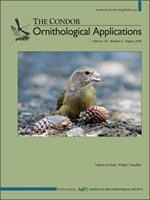The winter range of the Bicknell's Thrush (Catharus bicknelli), a globally vulnerable Nearctic–Neotropical migratory songbird, is restricted to the Greater Antilles. Most birds occur on Hispaniola, where the species exhibits sexual habitat segregation, and where the loss of its preferred wet broadleaf habitats has been severe. Conservation of female-dominated habitats has been identified as a top priority for the species' preservation. During 2010, we conducted standardized field surveys for the Bicknell's Thrush in forests of the Dominican Republic's Cordillera Septentrional, an area of high importance for females. We combined occurrence data with environmental variables to create a model of thrush distribution and habitat selection in the region. Elevation (densities peaked at ∼600 m), aspect (northeastern slopes), the amount of forest cover within 1 km, and forest density best described thrush presence and abundance. As an example of how predictive models of abundance can inform conservation, we used the best model that contained only spatially explicit covariates to map predicted winter abundance of the Bicknell's Thrush. With the highest elevations in the study area (∼600 m) and the most intact forest cover, 2 scientific reserves contained the largest areas of high thrush abundance, but many privately held lands contained forest fragments predicted to contain thrushes. Applying criteria from our abundance model to a region-wide assessment of available private properties, we identified a 400-ha abandoned farm situated along the Cordillera Septentrional between existing protected areas that contained environmental conditions suitable for Bicknell's Thrushes. We used this information to identify, purchase, and create the Dominican Republic's first-ever private reserve, the 400-ha Reserva Privada Zorzal. Our model can be used to identify and prioritize additional lands for conservation of the Bicknell's Thrush in the region. Our approach could also be used elsewhere to make informed conservation decisions.
How to translate text using browser tools
6 June 2018
Modeling spatial variation in winter abundance to direct conservation actions for a vulnerable migratory songbird, the Bicknell's Thrush (Catharus bicknelli)
Kent P. McFarland,
John D. Lloyd,
Sarah J. K. Frey,
Patrick L. Johnson,
Richard B. Chandler,
Christopher C. Rimmer

The Condor
Vol. 120 • No. 3
August 2018
Vol. 120 • No. 3
August 2018
Bicknell's Thrush
Catharus bicknelli
Dominican Republic
habitat
Nearctic–Neotropical migratory songbird
point count
winter




